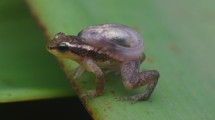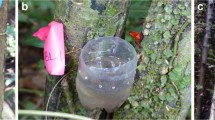Abstract
Parents may increase the probability of offspring survival by choosing suitable rearing sites where risks are as low as possible. Predation and competition are major selective pressures influencing the evolution of rearing site selection. Poison frogs look after their clutches and deposit the newly hatched tadpoles in bodies of water where they remain until metamorphosis. In some species, cannibalism occurs, so parents deposit their tadpoles singly in very small pools. However, cannibalism also occurs in species that deposit tadpoles in larger pools already occupied by heterospecific or conspecific larvae that could be either potential predators or competitors. Here, I test the hypothesis that, given the choice, males of Dendrobates tinctorius would deposit their newly hatched tadpoles in low-risk sites for their offspring. I characterised the pools used by D. tinctorius for tadpole deposition, conducted experiments to determine the larval traits that predict the occurrence of and latency to cannibalism, and tested whether parents deposit their tadpoles in low-risk pools. I found that (1) neither pool capacity nor the presence of other larvae predict the presence/absence or number of tadpoles; (2) cannibalism occurs often, and how quickly it occurs depends on the difference in size between the tadpoles involved; and (3) the likelihood of males depositing their tadpoles in occupied pools increases with the size of the resident tadpole. I suggest that predation/cannibalism is not the only factor that parents assess when choosing deposition sites, and that the presence of larger conspecifics may instead provide information about pool quality and stability.




Similar content being viewed by others
References
Alford RA (1999) Ecology: resource use, competition and predation. In: McDiarmid RW, Altig R (eds) Tadpoles. The biology of anuran larvae. University of Chicago, Chicago, pp 240–278
Alford RA, Wilbur HM (1985) Priority effects in experimental pond communities. Competition between Bufo and Rana. Ecology 66:1097–1105
Altermatt F, Pajunen VI, Ebert D (2009) Desiccation of rock pool habitats and its influence on population persistence in a Daphnia metacommunity. PLoS ONE 4:e4703
Alvarez D, Nicieza AG (2002) Effects of temperature and food quality on anuran larval growth and metamorphosis. Funct Ecol 16:640–648
Aspbury AS, Juliano SA (1998) Negative effects of habitat drying and prior exploitation on the detritus resource in an ephemeral aquatic habitat. Oecologia 115:137–148
Blaustein L, Kotler BP (1993) Oviposition habitat selection by the mosquito, Culiseta longiareolata: effects of conspecifics, food and green toad tadpoles. Ecol Entomol 18:104–108
Blaustein L, Margalit J (1996) Priority effects in temporary pools: nature and outcome of mosquito larva-toad tadpole interactions depend on order of entrance. J Anim Ecol 65:77–84
Blaustein L, Kiflawi M, Eitam A, Mangel M, Cohen JE (2004) Oviposition habitat selection in response to risk of predation in temporary pools: mode of detection and consistency across experimental venue. Oecologia 138:300–305
Born M, Bongers F, Poelman EH, Sterck FJ (2010) Dry-season retreat and dietary shift of the dart-poison frog Dendrobates tinctorius (Anura: Dendrobatidae). Phyllomedusa 9:37–52
Brown GP, Shine R (2004) Maternal nest-site choice and offspring fitness in a tropical snake (Tropidonophis mairii, Colubridae). Ecology 85:1627–1634
Brown GP, Shine R (2005) Nesting snakes (Tropidonophis mairii, Colubridae) selectively oviposit in sites that provide evidence of previous successful hatching. Can J Zool 83:1134–1137
Brown JL, Morales V, Summers K (2008a) Divergence in parental care, habitat selection and larval life history between two species of Peruvian poison frogs: an experimental analysis. J Evol Biol 21:1534–1543
Brown JL, Twomey E, Morales V, Summers K (2008b) Phytotelm size in relation to parental care and mating strategies in two species of Peruvian poison frogs. Behaviour 145:1139–1165
Brown JL, Morales V, Summers K (2009) Tactical reproductive parasitism via larval cannibalism in Peruvian poison frogs. Biol Lett 5:148–151
Brust DG (1990) Maternal brood care by Dendrobates pumilio: a frog that feeds its young. PhD Dissertation, Cornell University, New York
Brust DG (1993) Maternal brood care by Dendrobates pumilio. A frog that feeds its young. J Herpetol 27:96–98
Caldwell JP, De Araújo MC (1998) Cannibalistic interactions resulting from indiscriminate predatory behavior in tadpoles of poison frogs (Anura: Dendrobatidae). Biotropica 30:92–103
Caldwell JP, de Oliveira VRL (1999) Determinants of biparental care in the spotted poison frog, Dendrobates vanzolinii (Anura: Dendrobatidae). Copeia 1999:565–575
Courtois EA, Devillechabrolle J, Dewynter M, Pineau K, Gaucher P, Chave J (2013) Monitoring strategy for eight amphibian species in French Guiana, South America. PLoS ONE 8:e67486
Crump ML (1991) Choice of oviposition site and the load assessment by a treefrog. Herpetologica 47:308–315
Crump ML (1996) Parental care among the Amphibia. Adv Stud Behav 25:109–144
Donnelly MA (1989) Effects of reproductive resource supplementation on space-use patterns in Dendrobates pumilio. Oecologia 81:212–218
Edgerly JS, McFarland M, Morgan P, Livdahl T (1998) A seasonal shift in egg-laying behaviour in response to cues of future competition in a treehole mosquito. J Anim Ecol 67:805–818
Eitam A, Blaustein L, Mangel M (2005) Density and intercohort priority effects on larval Salamandra salamandra in temporary pools. Oecologia 146:36–42
Fincke OM (1992a) Consequences of larval ecology for territoriality and reproductive success of a neotropical damselfly. Ecology 73:449–462
Fincke OM (1992b) Interspecific competitionfor treeholes. Consequences for mating systems and coexistence in neotropical damselflies. Am Nat 139:80–101
Fincke OM (1999) Organization of predator assemblages in Neotropical tree holes: effects of abiotic factors and priority. Ecol Entomol 24:13–23
Grant T, Frost DR, Caldwell JP, Gagliardo R, Haddad CFB, Kok PJR, Means DB, Noonan BP, Schargel WE, Wheeler WC (2006) Phylogenetic systematics of dart-poison frogs and their relatives (Amphibia: Athesphatanura: Dendrobatidae). Bull Am Mus Nat Hist 299:6–262
Grimaldi M, Riéra B (2001) Geography and climate. In: Bongers F, Charles-Dominique P, Forget P-M, Théry M (eds) Nouragues: dynamics and plant–animal interactions in a neotropical rainforest. Kluwer, Dordrecht, pp 9–18
Harris RN (1999) The anuran tadpole: evolution and maintenance. In: McDiarmid RW, Altig R (eds) Tadpoles. The biology of anuran larvae. University of Chicago, Chicago, pp 279–294
Hernandez JP, Chalcraft DR (2012) Synergistic effects of multiple mechanisms drive priority effects within a tadpole assemblage. Oikos 121:259–267
Kats LB, Sih A (1992) Oviposition site selection and avoidance of fish by streamside salamanders (Ambystoma barbouri). Copeia 1992:468–473
Kershenbaum A, Spencer M, Blaustein L, Cohen JE (2012) Modelling evolutionarily stable strategies in oviposition site selection, with varying risks of predation and intraspecific competition. Evol Ecol 26:955–974
Knight CM, Parris MJ, Gutzke WHN (2009) Influence of priority effects and pond location on invaded larval amphibian communities. Biol Invasions 11:1033–1044
Lawler SP, Morin PJ (1993) Temporal overlap, competition, and priority effects in larval anurans. Ecology 74:174–182
Lehtinen RM, Lannoo MJ, Wassersug RJ (2004) Phytotelm-breeding anurans: past, present, and future research. Misc Publ Mus Zool Univ Michigan 193:1–10
Lötters S, Jungfer K-H, Henkel FW, Schmidt W (2007) Poison frogs: biology, species and captive husbandry. Edition Chimaira, Frankfurt
Maple M (2002) Maternal effects on offspring fitness in Dendrobates pumilio, the strawberry poison frog. PhD Dissertation, University of Kentucky, Lexington
Menard S (2001) Applied logistic regression analysis. Sage, Thousand Oaks
Mokany A, Shine R (2002) Competition between tadpoles and mosquitoes: the effects of larval density and tadpole size. Aust J Zool 50:549–563
Mokany A, Shine R (2003) Oviposition site selection by mosquitoes is affected by cues from conspecific larvae and anuran tadpoles. Aust Ecol 28:33–37
Murphy PJ (2003) Context-dependent reproductive site choice in a Neotropical frog. Behav Ecol 14:626–633
Noonan BP, Gaucher P (2006) Refugial isolation and secondary contact in the dyeing poison frog Dendrobates tinctorius. Mol Ecol 15:4425–4435
Poelman EH, Dicke M (2007) Offering offspring as food to cannibals: oviposition strategies of Amazonian poison frogs (Dendrobates ventrimaculatus). Evol Ecol 21:215–227
Polis GA, Myers CA, Holt RD (1989) The ecology and evolution of intraguild predation. Annu Rev Ecol Syst 20:297–330
Resetarits WJ, Wilbur HM (1989) Choice of oviposition site by Hyla chrysoscelis: role of predators and competitors. Ecology 70:220–228
Rieger JF, Binckley CA, Resetarits WJ (2004) Larval performance and oviposition site preference along a predation gradient. Ecology 85:2094–2099
Ringler E, Pasukonis A, Hödl W, Ringler M (2013) Tadpole transport logistics in a Neotropical poison frog: indications for strategic planning and adaptive plasticity in anuran parental care. Front Zool 10:67
Robertson BA (2009a) The influence of spatio-temporal variation in food availability and nest-predation risk on clutch-size decisions. Condor 111:523–533
Robertson BA (2009b) Nest-site selection in a postfire landscape: do parents make tradeoffs between microclimate and predation risk? Auk 126:500–510
Rojas B, Endler JA (2013) Sexual dimorphism and intra-populational colour pattern variation in the aposematic frog Dendrobates tinctorius. Evol Ecol 27:739–753
Rudolf VHW, Rödel M-O (2005) Oviposition site selection in a complex and variable environment: the role of habitat quality and conspecific cues. Oecologia 142:316–325
Ryan MJ, Barry DS (2011) Competitive interactions in phytotelmata-breeding pools of two poison-dart frogs (Anura: Dendrobatidae) in Costa Rica. J Herpetol 45:438–443
Sadeh A, Mangel M, Blaustein L (2009) Context-dependent reproductive habitat selection: the interactive roles of structural complexity and cannibalistic conspecifics. Ecol Lett 12:1158–1164
Schulte LM, Lötters S (2013) The power of the seasons: rainfall triggers parental care in poison frogs. Evol Ecol 27:711–723
Schulte LM, Yeager J, Schulte R, Veith M, Werner P, Beck LA, Lötters S (2011) The smell of success: choice of larval rearing sites by means of chemical cues in a Peruvian poison frog. Anim Behav 81:1147–1154
Silberbush A, Blaustein L (2011) Mosquito females quantify risk of predation to their progeny when selecting an oviposition site. Funct Ecol 25:1091–1095
Stynoski JL (2009) Discrimination of offspring by indirect recognition in an egg-feeding dendrobatid frog, Oophaga pumilio. Anim Behav 78:1351–1356
Summers K (1990) Paternal care and the cost of polygyny in the green dart-poison frog. Behav Ecol Sociobiol 27:307–313
Summers K (1999) The effects of cannibalism on Amazonian poison frog egg and tadpole deposition and survivorship in Heliconia axil pools. Oecologia 119:557–564
Summers K, Amos W (1997) Behavioral, ecological, and molecular genetic analyses of reproductive strategies in the Amazonian dart-poison frog, Dendrobates ventrimaculatus. Behav Ecol 8:260–267
Summers K, McKeon CS (2004) The evolutionary ecology of phytotelmata use in neotropical poison frogs. Misc Publ Mus Zool Univ Michigan 193:55–73
Thompson JN, Pellmyr O (1991) Evolution of oviposition behavior and host preference in Lepidoptera. Annu Rev Entomol 36:65–89
Twomey E, Morales V, Summers K (2008) Evaluating condition-specific and asymmetric competition in a species-distribution context. Oikos 117:1175–1184
von May R, Reider KE, Summers K (2009) Effect of body size on intraguild predation between tadpoles of bamboo-breeding poison frogs and predaceous mosquito larvae. J Freshw Ecol 24:431–435
Wildy EL, Chivers DP, Kiesecker JM, Blaustein AR (1998) Cannibalism enhances growth in larval long-toed salamanders (Ambystoma macrodactylum). J Herpetol 32:286–289
Acknowledgments
This study was funded by the CIE at Deakin University (Australia). J. Devillechabrolle provided invaluable field assistance, the staff at Nouragues station helped with logistics and P. Gaucher shared his knowledge on the species. I am grateful to John Endler, Karen Warkentin, Jason Brown and anonymous reviewers for helpful comments that improved the manuscript. Many thanks to Andrés López-Sepulcre and Janne Valkonen for statistical advice, and to the “Darwin” group at the University of Jyväskylä for a fruitful discussion on this work.
Ethical standards
This study was done in compliance with local regulations. Research permits were issued by the CNRS-Guyane.
Conflict of interest
There is no conflict of interest with the institution that funded this study.
Author information
Authors and Affiliations
Corresponding author
Additional information
Communicated by K. Warkentin
Rights and permissions
About this article
Cite this article
Rojas, B. Strange parental decisions: fathers of the dyeing poison frog deposit their tadpoles in pools occupied by large cannibals. Behav Ecol Sociobiol 68, 551–559 (2014). https://doi.org/10.1007/s00265-013-1670-y
Received:
Revised:
Accepted:
Published:
Issue Date:
DOI: https://doi.org/10.1007/s00265-013-1670-y




